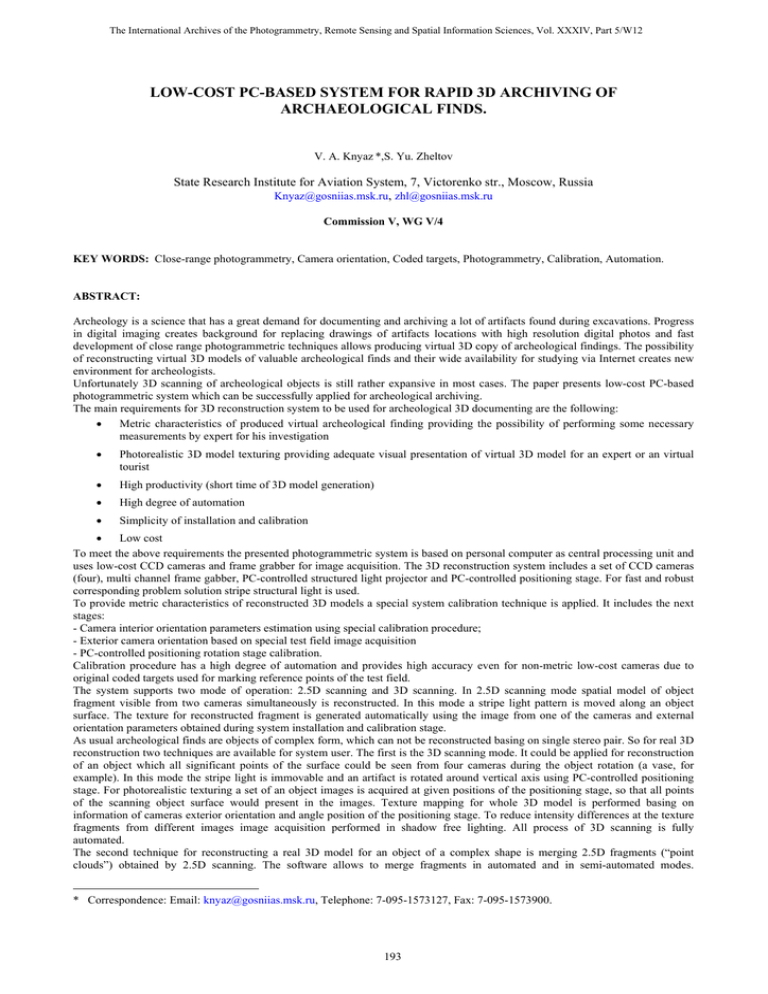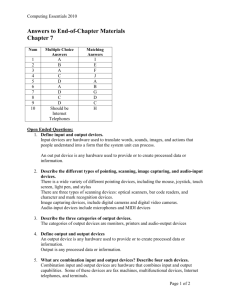LOW-COST PC-BASED SYSTEM FOR RAPID 3D ARCHIVING OF ARCHAEOLOGICAL FINDS.
advertisement

The International Archives of the Photogrammetry, Remote Sensing and Spatial Information Sciences, Vol. XXXIV, Part 5/W12 LOW-COST PC-BASED SYSTEM FOR RAPID 3D ARCHIVING OF ARCHAEOLOGICAL FINDS. V. A. Knyaz *,S. Yu. Zheltov State Research Institute for Aviation System, 7, Victorenko str., Moscow, Russia Knyaz@gosniias.msk.ru, zhl@gosniias.msk.ru Commission V, WG V/4 KEY WORDS: Close-range photogrammetry, Camera orientation, Coded targets, Photogrammetry, Calibration, Automation. ABSTRACT: Archeology is a science that has a great demand for documenting and archiving a lot of artifacts found during excavations. Progress in digital imaging creates background for replacing drawings of artifacts locations with high resolution digital photos and fast development of close range photogrammetric techniques allows producing virtual 3D copy of archeological findings. The possibility of reconstructing virtual 3D models of valuable archeological finds and their wide availability for studying via Internet creates new environment for archeologists. Unfortunately 3D scanning of archeological objects is still rather expansive in most cases. The paper presents low-cost PC-based photogrammetric system which can be successfully applied for archeological archiving. The main requirements for 3D reconstruction system to be used for archeological 3D documenting are the following: • Metric characteristics of produced virtual archeological finding providing the possibility of performing some necessary measurements by expert for his investigation • Photorealistic 3D model texturing providing adequate visual presentation of virtual 3D model for an expert or an virtual tourist • High productivity (short time of 3D model generation) • High degree of automation • Simplicity of installation and calibration • Low cost To meet the above requirements the presented photogrammetric system is based on personal computer as central processing unit and uses low-cost CCD cameras and frame grabber for image acquisition. The 3D reconstruction system includes a set of CCD cameras (four), multi channel frame gabber, PC-controlled structured light projector and PC-controlled positioning stage. For fast and robust corresponding problem solution stripe structural light is used. To provide metric characteristics of reconstructed 3D models a special system calibration technique is applied. It includes the next stages: - Camera interior orientation parameters estimation using special calibration procedure; - Exterior camera orientation based on special test field image acquisition - PC-controlled positioning rotation stage calibration. Calibration procedure has a high degree of automation and provides high accuracy even for non-metric low-cost cameras due to original coded targets used for marking reference points of the test field. The system supports two mode of operation: 2.5D scanning and 3D scanning. In 2.5D scanning mode spatial model of object fragment visible from two cameras simultaneously is reconstructed. In this mode a stripe light pattern is moved along an object surface. The texture for reconstructed fragment is generated automatically using the image from one of the cameras and external orientation parameters obtained during system installation and calibration stage. As usual archeological finds are objects of complex form, which can not be reconstructed basing on single stereo pair. So for real 3D reconstruction two techniques are available for system user. The first is the 3D scanning mode. It could be applied for reconstruction of an object which all significant points of the surface could be seen from four cameras during the object rotation (a vase, for example). In this mode the stripe light is immovable and an artifact is rotated around vertical axis using PC-controlled positioning stage. For photorealistic texturing a set of an object images is acquired at given positions of the positioning stage, so that all points of the scanning object surface would present in the images. Texture mapping for whole 3D model is performed basing on information of cameras exterior orientation and angle position of the positioning stage. To reduce intensity differences at the texture fragments from different images image acquisition performed in shadow free lighting. All process of 3D scanning is fully automated. The second technique for reconstructing a real 3D model for an object of a complex shape is merging 2.5D fragments (“point clouds”) obtained by 2.5D scanning. The software allows to merge fragments in automated and in semi-automated modes. * Correspondence: Email: knyaz@gosniias.msk.ru, Telephone: 7-095-1573127, Fax: 7-095-1573900. 193 The International Archives of the Photogrammetry, Remote Sensing and Spatial Information Sciences, Vol. XXXIV, Part 5/W12 Automated mode could be applied for objects having matching obstacles for overlapping parts of the merging 2.5D fragments. The software finds coincident parts of the fragments and calculates transition matrix to merge this fragments. If fragments shape does not allow to match overlapping parts semi-automated mode is applied. In semi-automated mode user has to indicate at least one corresponding points for overlapping part of two fragments. Then software automatically finds the best fitting for processed fragments. The developed system was used for 3D reconstruction of complex shaped object such a human skull, ancient stone engraving, sculpture. The precision of object spatial coordinates reconstruction for working space about 250x250x200 mm is at the level of 0.2 mm. The time needed for 2.5D scanning is about 40 seconds, for 3D scanning – is about 4 minutes. The achieved characteristics seem to be adequate for purposes of 3D archeological documenting. 194






